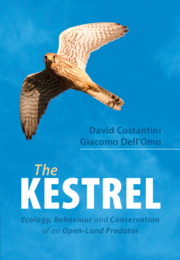Book contents
- The Kestrel
- The Kestrel
- Copyright page
- Contents
- Preface
- 1 Systematics and Evolution of Kestrels
- 2 Feeding Ecology
- 3 Habitat Use
- 4 Breeding Density and Nest Site Selection
- 5 Colourations, Sexual Selection and Mating Behaviour
- 6 The Reproductive Cycle: From Egg Laying to Offspring Care
- 7 Ecological Physiology and Immunology
- 8 Environmental Toxicology
- 9 Movement Ecology
- 10 Conservation Status and Population Dynamics
- References
- Index
- Plate Section (PDF Only)
2 - Feeding Ecology
Published online by Cambridge University Press: 29 August 2020
- The Kestrel
- The Kestrel
- Copyright page
- Contents
- Preface
- 1 Systematics and Evolution of Kestrels
- 2 Feeding Ecology
- 3 Habitat Use
- 4 Breeding Density and Nest Site Selection
- 5 Colourations, Sexual Selection and Mating Behaviour
- 6 The Reproductive Cycle: From Egg Laying to Offspring Care
- 7 Ecological Physiology and Immunology
- 8 Environmental Toxicology
- 9 Movement Ecology
- 10 Conservation Status and Population Dynamics
- References
- Index
- Plate Section (PDF Only)
Summary
The common kestrel is a generalist predator. However, it also shows significant within-species variation in food habits, such as local specialisations on given prey (e.g. voles in northern or lizards in southern Europe) or even individual food preferences. This chapter illustrates the factors that affect the diet composition of kestrels, their foraging strategies and the processes of food competition, including kleptoparasitism. It also explores the last-generation techniques, such as stable isotope analyses and accelerometer-GPS loggers, that would enable the limits of classic methods used to study the feeding ecology of kestrels to be overcome.
- Type
- Chapter
- Information
- The KestrelEcology, Behaviour and Conservation of an Open-Land Predator, pp. 18 - 37Publisher: Cambridge University PressPrint publication year: 2020

